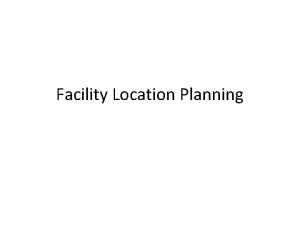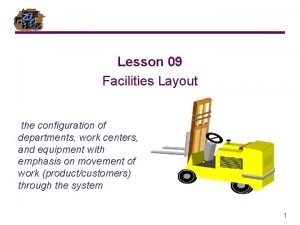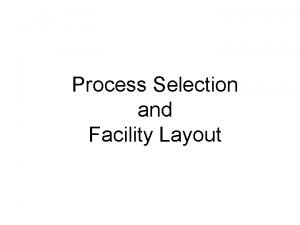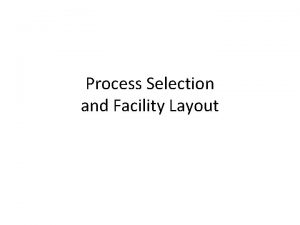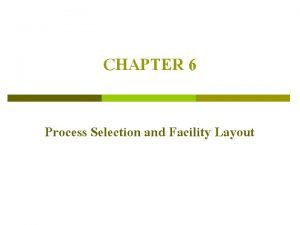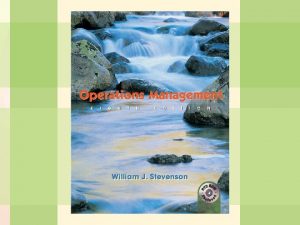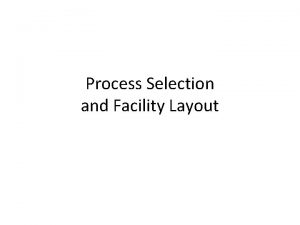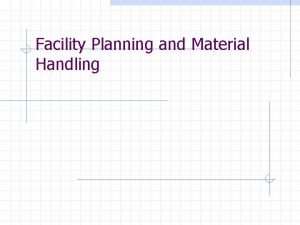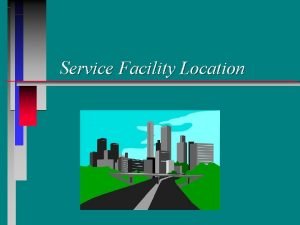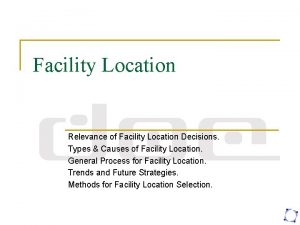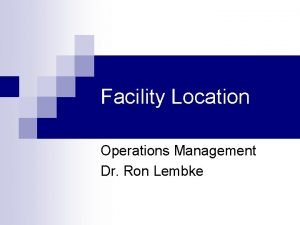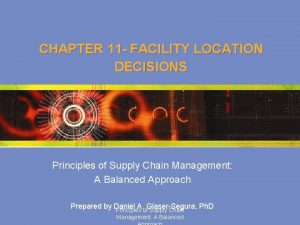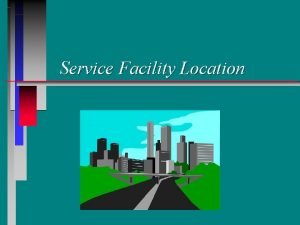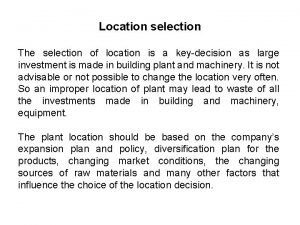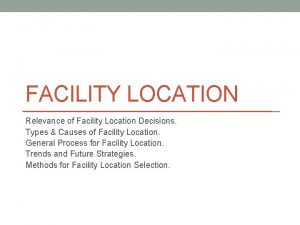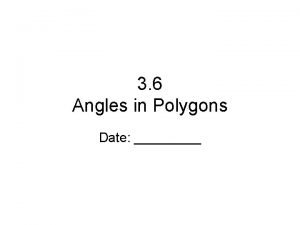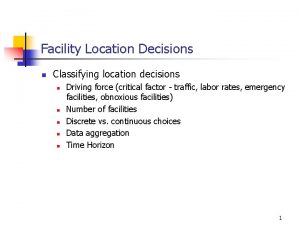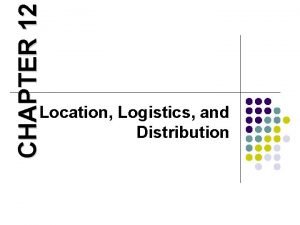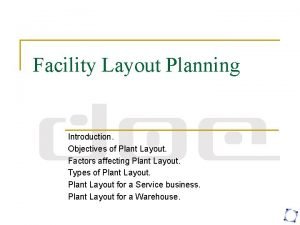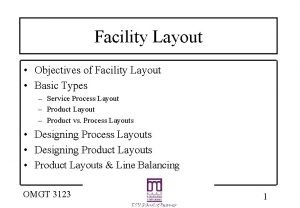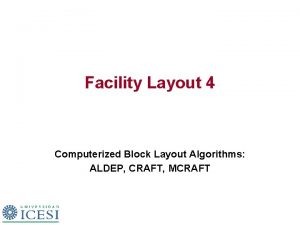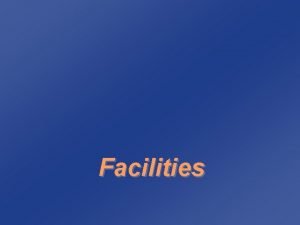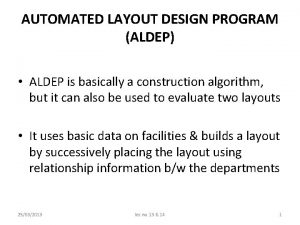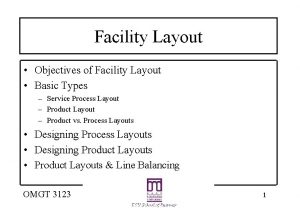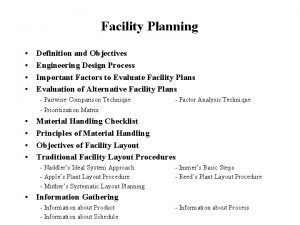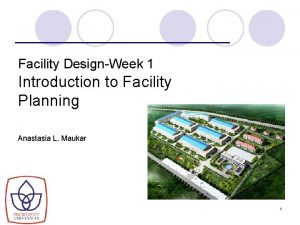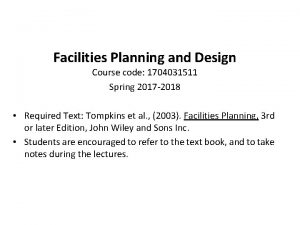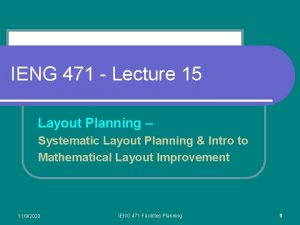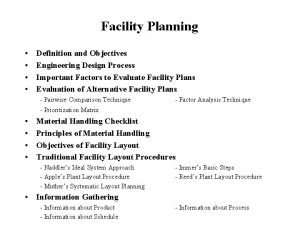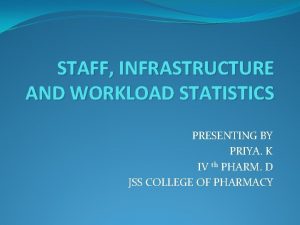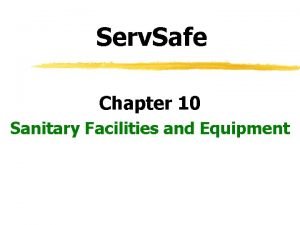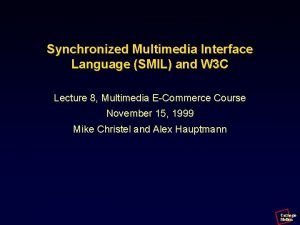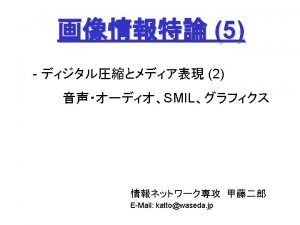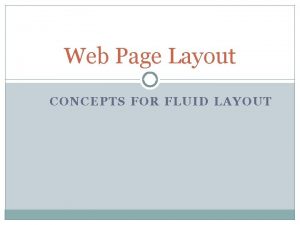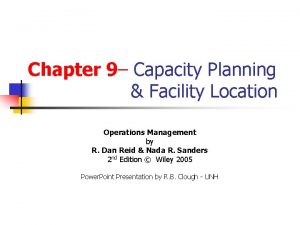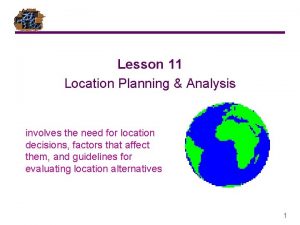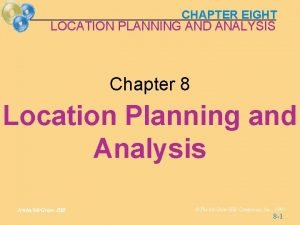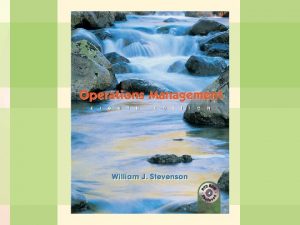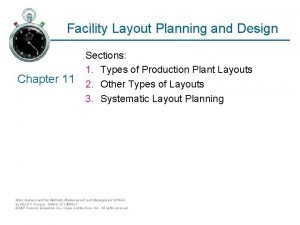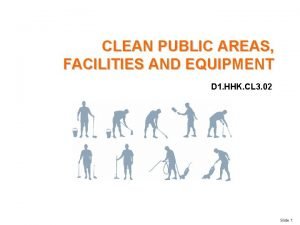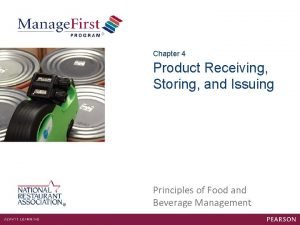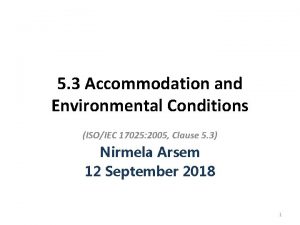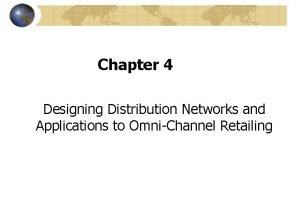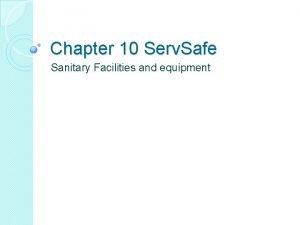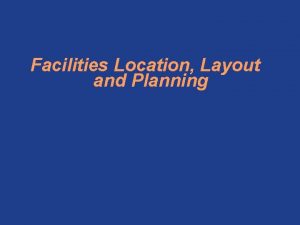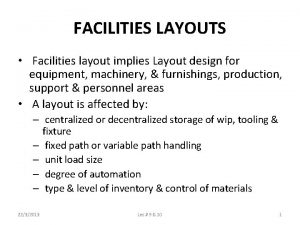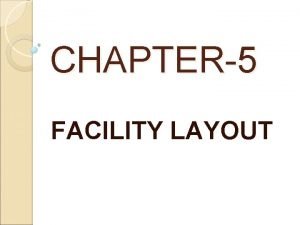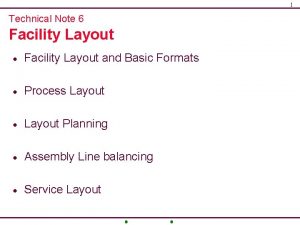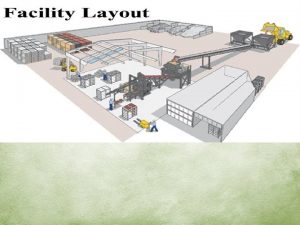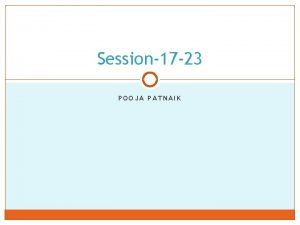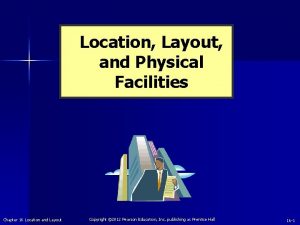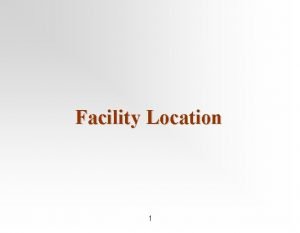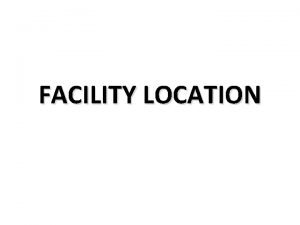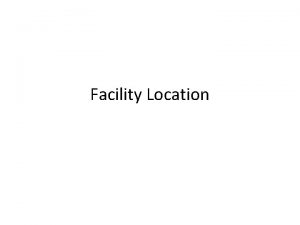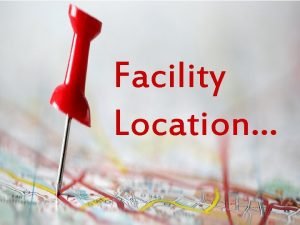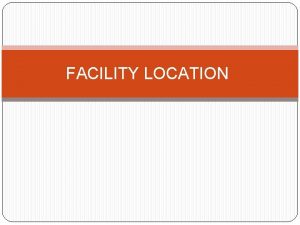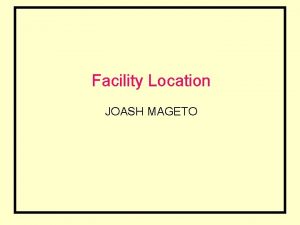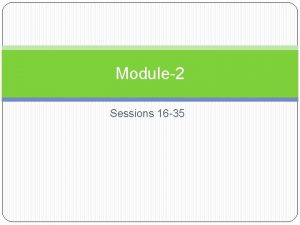Facilities Location Layout and Planning FACILITY PLANNING The

















































































- Slides: 81

Facilities Location, Layout and Planning

FACILITY PLANNING • The placement of facility – customers, suppliers, other links in the supply chain • Resources • Strategy – 99 cents Only example • Access to customers • Government impacts

Objectives of Facility Layout ü Minimize material handling costs ü Utilize space efficiently ü Utilize labor efficiently ü Eliminate bottlenecks ü Facilitate communication and interaction between workers, between workers and their supervisors, or between workers and customers ü Reduce manufacturing cycle time or customer service time

Objectives of Facility Layout ü Eliminate waste or redundant movement ü Facilitate the entry, exit, and placement of material, products, or people ü Incorporate safety and security measures ü Promote product and service quality ü Encourage proper maintenance activities ü Provide a visual control of operations or activities ü Provide flexibility to adapt to changing conditions ü Increase capacity

Questions on Layout Planning • How should the facility be laid out? • Does my layout cause unnecessary movement/excess travel time? • Does my work flow in a logical manner? • Does size dictate layout or does layout/product flow dictate the size?

Basic Types of Layouts ü Process Layout ü Machines grouped by process they perform ü Product Layout ü Linear arrangement of workstations to produce a specific product ü Fixed Position Layout ü Used in projects where the product cannot be moved

Manufacturing Process Layout Lathe Department L L L L L Milling Department Drilling Department M M D D D D G G G P Grinding Department Receiving and Shipping Painting Department A A Assembly A

Manufacturing Process Layout Lathe Department L L L L L Milling Department Drilling Department M M D D D D G G G P Grinding Department Receiving and Shipping Painting Department A A Assembly A

Manufacturing Process Layout Lathe Department L L L L L Milling Department Drilling Department M M D D D D G G G P Grinding Department Receiving and Shipping Painting Department A A Assembly A

A Product Layout In Out

Fixed-Position Layouts ü Typical of projects ü Equipment, workers, materials, other resources brought to the site ü Highly skilled labor ü Often low fixed ü Typically high variable costs

Designing Process Layouts ü Minimize material handling costs ü Block Diagramming ü Minimize nonadjacent loads ü Use when quantitative data is available ü Relationship Diagramming ü Based on location preference between areas ü Use when quantitative data is not available

Block Diagramming ü Create load summary chart ü Calculate composite (two way) movements ü Develop trial layouts minimizing number of nonadjacent loads ü Example


Relationship Diagramming (Murther’s Grid) ü Used when quantitative data is not available ü Muther’s grid displays preferences ü Denote location preferences with weighted lines

Relationship Diagramming Example Production Offices Stockroom Shipping and receiving Locker room Toolroom

Relationship Diagramming Example A Absolutely E Production Offices Stockroom Shipping and receiving Locker room Toolroom O U A U O A O U O I X O E U I O U X A necessary Especially important Important Okay Unimportant Undesirable

Relationship Diagramming Example 1 Absolutely 2 Production Offices Stockroom Shipping and receiving Locker room Toolroom 4 5 1 5 4 1 4 5 4 3 6 4 2 5 3 4 5 6 1 necessary Especially important Important Okay Unimportant Undesirable


Facility Location Models

Types Of Facilities ü Heavy manufacturing üAuto plants, steel mills, chemical plants ü Light industry üSmall components mfg, assembly ü Warehouse & distribution centers ü Retail & service

Factors in Heavy Manufacturing Location ü Construction costs ü Land costs ü Raw material and finished goods shipment modes ü Proximity to raw materials ü Utilities ü Labor availability

Factors in Light Industry Location ü Construction costs ü Land costs ü Easily accessible geographic region ü Education & training capabilities

Factors in Warehouse Location ü Transportation costs ü Proximity to markets (Customers)



Service Location Considerations • • • Labor Cost of Living Real Estate Construction Government Incentives Examples – Amoco, Mass St, Tattoo Parlors, Walgreen’s

Global Location Factors ü Government stability ü Government regulations ü Political and economic systems ü Economic stability and growth ü Exchange rates ü Culture ü Climate ü Export import regulations, duties and tariffs ü Raw material availability ü Number and proximity of suppliers ü Transportation and distribution system ü Labor cost and education ü Available technology ü Commercial travel ü Technical expertise ü Cross-border trade regulations ü Group trade agreements

Regional Location Factors ü Community government ü Local business regulations ü Government services ü Business climate ü Community services ü Taxes ü Availability of sites ü Financial Services ü Community inducements ü Proximity of suppliers ü Education system

Site Location Factors ü Customer base ü Construction/ leasing cost ü Land cost ü Site size ü Transportation ü Utilities ü Zoning restrictions ü Traffic ü Safety/security ü Competition ü Area business climate ü Income level

Location Incentives ü Tax credits Wal-Mart in Wyandotte ü Relaxed government regulation ü Job training ü Infrastructure improvement ü Money

Center-of-Gravity Technique ü Locate facility at center of geographic area ü Based on weight and distance traveled ü Establish grid-map of area ü Identify coordinates and weights shipped for each location

Facility Summary • Why is it important? • Location analysis • Location Criteria – global, local, regional - education • Location and Strategy • Location and Customers • Layout planning

Project Management and Operations

Project Management First Essay on Project Management: 1697 – “An Essay Upon Projects” 1959 HBR Article – “The Project Manager” Air Force Manual 1964

Project Management In today’s global marketplace, complexity and speed are certainties. In such an environment, a good axiom for project management is, Do It Right, Do It Right Now. Creating clear direction, efficiency, timely response, and quality outcomes requires project managers who are agile -- adept at change. The associated disciplinary areas are clearly spelled out in the following PMI definition. “Project management is the application of knowledge, skills, tools, and techniques to a broad range of activities in order to meet the requirements of a particular project. Project management is comprised of five Project Management Process Groups – Initiating Processes, Planning Processes, Executing Processes, Monitoring and Controlling Processes, and Closing Processes. Source: Project Management Institute - http: //www. pmi. org/info/PP_About. Profession. Overview. asp? nav=0501

Elements of Project Management ü Project team ü Individuals from different departments within company ü Matrix organization ü Team structure with members from different functional areas depending on skills needed ü Project manager - Leader of project team ü Project Charter – high level description of what is to be accomplished in a project and delegates authority to project manager to implement actions to complete project

Project Planning ü Statement of work ü Written description of goals, work & time frame of project ü Activities require labor, resources & time ü Precedence relationship shows sequential relationship of project activities

Elements of Project Planning ü Define project objective(s) ü Identify activities ü Establish precedence relationships ü Make time estimates ü Determine project completion time ü Compare project schedule objectives ü Determine resource requirements to meet objective

Work Breakdown Structure ü Hierarchical organization of work to be done on a project ü Project broken down into modules ü Modules subdivided into subcomponents, activities, and tasks ü Identifies individual tasks, workloads, and resource requirements

Project Control ü All activities identified and included ü Completed in proper sequence ü Resource needs identified ü Schedule adjusted ü Maintain schedule and budget ü Complete on time

A Gantt Chart Around since 1914 ü Popular tool for project scheduling ü Graph with bar for representing the time for each task ü Provides visual display of project schedule ü Also shows slack for activities ü Amount of time activity can be delayed without delaying project

Gantt Charts Gantt described two principles for his charts: 1. measure activities by the amount of time needed to complete them 2. the space on the chart can be used the represent the amount of the activity that should have been done in that time. Gantt charts were employed on major infrastructure projects including the Hoover Dam and Interstate highway system and still are an important tool in project management.

A Gantt Chart 0 | 2 | Month 4 | 6 | 8 | Activity Design house and obtain financing Lay foundation Order and receive materials Build house Select paint Select carpet Finish work 1 Figure 6. 2 3 Month 5 7 9 10

Example of Gantt Chart Problem

CPM/PERT ü Critical Path Method (CPM) ü Du. Pont & Remington-Rand (1956) ü Deterministic task times ü Project Eval. & Review Technique (PERT) ü US Navy, Lockheed ü Multiple task time estimates

PERT/CPM Program Evaluation and Review Technique (PERT): developed in conjunction with the development of the Polaris missile program for submarines – developed by the US Navy with Lockheed as the lead contractor Critical Path Method (CPM): developed through a joint venture between the Du. Pont Corporation and the Remington Rand Corporation – the original purpose was to monitor and evaluate plant maintenance management projects.

Project Network for a House Lay foundation 1 3 Design house and obtain financing 2 3 2 Dummy 0 1 Order and receive materials 4 Select paint Build house 1 1 5 Figure 6. 4 6 3 Select carpet Finish work 1 7

Critical Path ü A path is a sequence of connected activities running from start to end node in network ü The critical path is the path with the longest duration in the network ü Project cannot be completed in less than the time of the critical path

The Critical Path 1 3 Lay foundation 2 3 Design house and obtain financing 2 Dummy Build house 0 1 Order and receive materials 4 Select paint Finish work 6 3 1 1 Select carpet 5 A: 1 -2 -3 -4 -6 -7 3 + 2 + 0 + 3 + 1 = 9 months B: 1 -2 -3 -4 -5 -6 -7 3 + 2 + 0 + 1 + 1 = 8 months C: 1 -2 -4 -6 -7 3 + 1 + 3 + 1 = 8 months D: 1 -2 -4 -5 -6 -7 3 + 1 + 1 = 7 months 1 7

The Critical Path 3 Lay foundation 2 3 1 Build house 0 1 2 Design house and obtain financing Dummy Order and receive materials 4 Select paint Finish work 6 3 1 1 7 1 Select carpet 5 Activity Start Times 3 Start at 5 months 2 1 3 2 0 1 4 6 3 1 1 Start at 3 months 5 Figure 6. 6 Finish at 9 months 1 7 Start at 8 months

Project Crashing ü Crashing is reducing project time by expending additional resources ü Crash time is an amount of time an activity is reduced ü Crash cost is the cost of reducing the activity time ü Goal is to reduce project duration at minimum cost

Time-Cost Relationship ü Crashing costs increase as project duration decreases ü Indirect costs increase as project duration increases ü Reduce project length as long as crashing costs are less than indirect costs

Life Cycle Management • Long term view of projects to guide decision making – solutions that provide life time success vice short term • Acquisition; development; production; introduction; sustainment; disposal • Links system costs to big picture; better use of resources; minimize total cost of ownership

Capacity and Aggregate Planning

Capacity Outputs: Examples

The goal of capacity planning decisions (1) The capacity of the firm to produce the service or good (2) The processes for providing the service or making the good (3) The layout or arrangement of the work space (4) The design of work processes to enhance productivity

Capacity • The max output that an organization be capable of producing • Measure a single facility: – Design vs. Effective capacity – Capacity Utilization: design vs. efficient utilization • For systems have more than one facility and flows of product – System capacity and bottleneck – Improve system capacity

Determinants of Effective Capacity • Facilities • Human considerations – Adding people – Increasing employee motivation • Operations – Improving operating rate of a machine – Improving quality of raw materials and components • External forces – Safety regulations

Capacity Utilization Measures how much of the available capacity is actually being used: – Always <=1(percentage of usage) – Higher the better – Denominator: • If effective capacity used: efficient utilization • If design capacity used: design utilization

Aggregate Planning • The process of planning the quantity and timing of output over the intermediate range (3 -18 months) by adjusting production rate, employment, inventory • Master Production Schedule: formalizes the production plan and translates it into specific end item requirements over the short to intermediate horizon

Capacity Planning • The process of determining the amount of capacity required to produce in the future. May be at the aggregate or product line level • Master Production Schedule anticipated build schedule • Time horizon must exceed lead times for materials

Capacity Planning • Look at lead times, queue times, set up times, run times, wait times, move times • Resource availability • Material and capacity - should be in synch • driven by dispatch list - listing of manufacturing orders in priority sequence - ties to layout planning • load profiles - capacity of each section

the capacity decisions: • • When to add capacity How much capacity to add Where to add capacity What type of capacity to add • When to reduce capacity

Capacity Planning • Rough Cut Capacity Planning process of converting the master production schedule into requirements for key resources • capacity requirements plan - timephased display of present and future capacity required on all resources based on planned and released orders

Capacity Planning • Capacity Requirements Planning (CRP) - process of determining in detail the amount of labor and machine resources required to meet production plan • RCCP may indicate sufficient capacity but the CRP may indicate insufficient capacity during specific time periods

Theory of Constraints • Every system has a bottle neck • capacity of the system is constrained by the capacity of the bottle neck • increasing capacity at other than bottle neck operations does not increase the overall capacity of the system

Theory of Constraints • What needs to be changed • What to change to • How to make the change happen

Theory of Constraints • • • Identify the constraint Subordinate Inertia Walk the process again inertia of change can create new bottle necks

Capacity Planning ü Establishes overall level of productive resources ü Affects lead time responsiveness, cost & competitiveness ü Determines when and how much to increase capacity

Capacity Expansion ü Volume & certainty of anticipated demand ü Strategic objectives for growth ü Costs of expansion & operation ü Incremental or one-step expansion

Sales and Operations Planning (S&OP) • Brings together all plans for business • performed at least once a month • Internal and external

Adjusting Capacity to Meet Demand 1. Producing at a constant rate and using inventory to absorb fluctuations in demand (level production) 2. Hiring and firing workers to match demand (chase demand) 3. Maintaining resources for high demand levels 4. Increase or decrease working hours (overtime and undertime) 5. Subcontracting work to other firms 6. Using part-time workers 7. Providing the service or product at a later time period (backordering)

Demand Management ü Shift demand into other periods ü Incentives, sales promotions, advertising campaigns ü Offer product or services with countercyclical demand patterns ü Partnering with suppliers to reduce information distortion along the supply chain

Remedies for Underloads 1. Acquire more work 2. Pull work ahead that is scheduled for later time periods 3. Reduce normal capacity

Remedies for Overloads 1. Eliminate unnecessary requirements 2. Reroute jobs to alternative machines or work centers 3. Split lots between two or more machines 4. Increase normal capacity 5. Subcontract 6. Increase the efficiency of the operation 7. Push work back to later time periods 8. Revise master schedule

Scheduling as part of the Planning Process

Scheduling • Scheduling is the last step in the planning process? • It is one of the most challenging areas of operations management. • Scheduling presents many day-to-day problems for operations managers because of – – Changes in customer orders Equipment breakdowns Late deliveries from suppliers A myriad of other disruptions

Objectives in Scheduling Ø Ø Ø Ø Ø Meet customer due dates Minimize job lateness Minimize response time Minimize completion time Minimize time in the system Minimize overtime Maximize machine or labor utilization Minimize idle time Minimize work-in-process inventory Efficiency

Sequencing Rules Ø Ø Ø Ø Ø FCFS - first-come, first-served LCFS - last come, first served DDATE - earliest due date CUSTPR - highest customer priority SETUP - similar required setups SLACK - smallest slack CR - critical ratio SPT - shortest processing time LPT - longest processing time

Critical Ratio Rule CR considers both time and work remaining time remaining work remaining due date - today’s date remaining processing time If CR > 1, job ahead of schedule If CR < 1, job behind schedule If CR = 1, job on schedule Ties scheduling to Gantt Chart or PERT/CPM
 Contoh layout usaha
Contoh layout usaha Facility location planning
Facility location planning Factors affecting facility layout
Factors affecting facility layout Location planning in operations management
Location planning in operations management Facility layout
Facility layout Importance of process selection and facility layout
Importance of process selection and facility layout Process matrix
Process matrix Process selection and facility layout pdf
Process selection and facility layout pdf Process selection and facility layout
Process selection and facility layout Process selection and facility layout
Process selection and facility layout Process selection and facility layout
Process selection and facility layout Facility planning
Facility planning Cross-median approach
Cross-median approach Types of facility location
Types of facility location Center of gravity method facility location example
Center of gravity method facility location example Location
Location Service facility location
Service facility location Facility location factors
Facility location factors Facility location decisions are complex because
Facility location decisions are complex because Interior exterior
Interior exterior Single facility location problem
Single facility location problem In the logistics-system design matrix
In the logistics-system design matrix Facility location game
Facility location game What are the objective of plant layout
What are the objective of plant layout Aeioux
Aeioux Meaning of facility layout
Meaning of facility layout Craft algorithm example
Craft algorithm example Muther's grid
Muther's grid Aldep algorithm example
Aldep algorithm example Product vs process layout
Product vs process layout Facility design process
Facility design process Define facility planning
Define facility planning Reject allowance problem facilities planning
Reject allowance problem facilities planning 33cfr105
33cfr105 Sed facilities planning
Sed facilities planning Facilities planning
Facilities planning Facility planning objectives
Facility planning objectives Marine facilities planning
Marine facilities planning Workload statistics in hospital pharmacy
Workload statistics in hospital pharmacy Defination of hospital pharmacy
Defination of hospital pharmacy Office in factory
Office in factory A cross country skier moves from location a
A cross country skier moves from location a Servsafe cutting board colors
Servsafe cutting board colors Denominator layout
Denominator layout Smil head layout root-layout
Smil head layout root-layout Mpeg-1
Mpeg-1 Fluid layout vs fixed layout
Fluid layout vs fixed layout Load distance method
Load distance method Location planning and analysis
Location planning and analysis Location planning and analysis
Location planning and analysis Location planning and analysis
Location planning and analysis Closeness rating
Closeness rating Clean public areas facilities and equipment
Clean public areas facilities and equipment Product issuing
Product issuing Front office operations and management ahmed ismail
Front office operations and management ahmed ismail Facilities and environmental conditions
Facilities and environmental conditions Desired response time and number of facilities
Desired response time and number of facilities Sanitary facilities and equipment
Sanitary facilities and equipment Providing support services facilities and other amenities
Providing support services facilities and other amenities Translators and facilities of languages
Translators and facilities of languages Safe facilities and pest management
Safe facilities and pest management Hình ảnh bộ gõ cơ thể búng tay
Hình ảnh bộ gõ cơ thể búng tay Lp html
Lp html Bổ thể
Bổ thể Tỉ lệ cơ thể trẻ em
Tỉ lệ cơ thể trẻ em Voi kéo gỗ như thế nào
Voi kéo gỗ như thế nào Chụp phim tư thế worms-breton
Chụp phim tư thế worms-breton Hát lên người ơi
Hát lên người ơi Các môn thể thao bắt đầu bằng tiếng đua
Các môn thể thao bắt đầu bằng tiếng đua Thế nào là hệ số cao nhất
Thế nào là hệ số cao nhất Các châu lục và đại dương trên thế giới
Các châu lục và đại dương trên thế giới Công thức tính độ biến thiên đông lượng
Công thức tính độ biến thiên đông lượng Trời xanh đây là của chúng ta thể thơ
Trời xanh đây là của chúng ta thể thơ Mật thư anh em như thể tay chân
Mật thư anh em như thể tay chân Phép trừ bù
Phép trừ bù độ dài liên kết
độ dài liên kết Các châu lục và đại dương trên thế giới
Các châu lục và đại dương trên thế giới Thơ thất ngôn tứ tuyệt đường luật
Thơ thất ngôn tứ tuyệt đường luật Quá trình desamine hóa có thể tạo ra
Quá trình desamine hóa có thể tạo ra Một số thể thơ truyền thống
Một số thể thơ truyền thống Bàn tay mà dây bẩn
Bàn tay mà dây bẩn Vẽ hình chiếu vuông góc của vật thể sau
Vẽ hình chiếu vuông góc của vật thể sau

